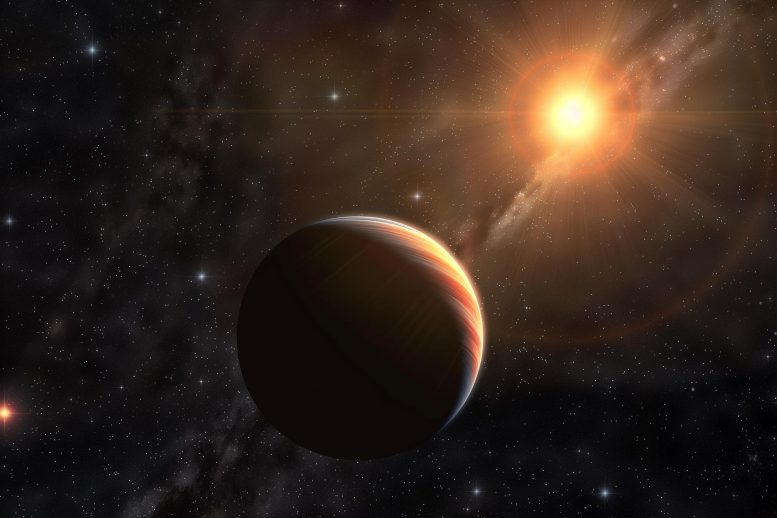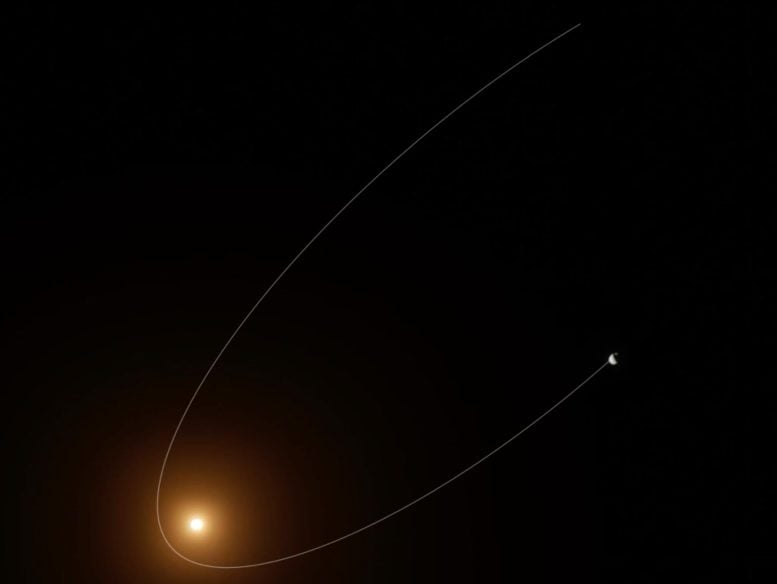
By Penn State August 13, 2024
Collected at: https://scitechdaily.com/backward-and-beyond-unraveling-the-mystery-of-eccentric-exoplanet-orbits/
An exoplanet’s strange elongated, backward orbit holds clues to the formation history and future trajectories of hot Jupiters.
Astronomers have identified an exoplanet with the most eccentric orbit known, characterized by its cucumber-like shape and backward motion around its star. This discovery offers insights into the formation and evolution of hot Jupiters. Key instruments such as the NEID and TESS were pivotal in observing this exoplanet, which may help understand the migration of these giant gas planets.
Discovery of a Unique Exoplanet
Researchers have discovered a planet that has the most oblong orbit ever found among transiting planets. The exoplanet’s extreme circuit — which looks closer to a cucumber than a circle — follows one of the most drastically stretched-out orbits of all known exoplanets, planets that orbit stars outside our solar system. It is also orbiting its star backwards, lending insight into the mystery of how close-in massive gas planets, known as hot Jupiters, form, stabilize and evolve over time.
The research, led by Penn State scientists, was published on July 17 in the journal Nature.
“We caught this massive planet making a sharp, hairpin turn during its close passage to its star,” said Suvrath Mahadevan, the Verne M. Willaman Professor of Astronomy at Penn State and author on the paper. “Such highly eccentric transiting planets are incredibly rare — and it’s really amazing that we were able to discover the most eccentric one.”

Insights From Orbital Eccentricity
Mahadevan explained that the term “eccentric” refers to the shape of a planet’s orbit, which is measured on a scale from zero to one, with zero being a perfectly circular orbit. This exoplanet, named TIC 241249530, has an orbital eccentricity of 0.94, making it more eccentric than the orbit of any other transiting exoplanet ever found. For comparison, Pluto’s highly elliptical orbit around the sun has an eccentricity of 0.25; Earth’s eccentricity is 0.02. Such an extreme orbit, Mahadevan explained, would cause temperatures on the planet to vary between that of a summer’s day at the farthest point in its orbit to blazing hot at its closest approach.
To add to the unusual nature of the exoplanet’s orbit, the team also found that it’s orbiting backward, meaning in a direction opposite to the rotation of its host star. This is not something that astronomers see in most other exoplanets, nor in our own solar system, and it helps inform the team’s interpretation of the exoplanet’s formation history.
Unraveling Hot Jupiter Formation
“While we can’t exactly press rewind and watch the process of planetary migration in real time, this exoplanet serves as a sort of snapshot of the migration process,” Arvind Gupta, NOIRLab postdoctoral researcher and lead author of the paper, who conducted the research as a doctoral student at Penn State, said in a NOIRLab release. “Planets like this are hard to find and we hope it can help us unravel the hot Jupiter formation story.”
At present, there are over 5,600 confirmed exoplanets in just over 4,000 star systems. Within this population, about 300 to 500 exoplanets fall into the curious class known as hot Jupiters — large, Jupiter-like exoplanets that orbit very close to their star, much closer than Mercury is to our sun. How hot Jupiters end up in such close orbits is a mystery, but astronomers suspect that they begin in orbits far from their star and then migrate inward over time. The early stages of this process have rarely been observed, but with this new analysis of an exoplanet with an unusual orbit, astronomers are one step closer to unraveling the hot Jupiter mystery.
“Astronomers have been searching for exoplanets that are likely precursors to hot Jupiters, or that are intermediate products of the migration process, for more than two decades, so I was very surprised — and excited — to find one,” Gupta said.
The discovery and characterization of the exoplanet was enabled by three instruments built at Penn State: the NASA-funded NEID spectrograph, the Habitable Zone Planet Finder spectrograph and a photometric diffuser. All three instruments allow researchers to observe and analyze light emitted by the exoplanet.
The Role of Advanced Instruments
The researchers first detected the planet using NASA’s Transiting Exoplanet Survey Satellite (TESS) in January 2020, which revealed a dip in a star’s brightness consistent with a single Jupiter-sized planet passing in front of the star. To confirm the nature of these fluctuations and eliminate other possible causes, a team of astronomers used two instruments on the WIYN 3.5-meter Telescope at the U.S. National Science Foundation (NSF) Kitt Peak National Observatory (KPNO), a program of NSF NOIRLab.
The team first utilized the NASA-funded NN-EXPLORE Exoplanet and Stellar Speckle Imager (NESSI) in a technique that helps to “freeze out” atmospheric twinkling, which showed that there were no extraneous stars nearby that could have confused the TESS measurements. Then, using the HPF and NEID spectrographs, the team observed how TIC 241249530’s spectrum, or wavelengths of its emitted light, shifted as a result of the exoplanet orbiting it.
“It’s so exciting to see such great science coming out of NEID within just a few years of operations,” said Andrea Lin, a co-author on the paper and doctoral student at Penn State who helped construct and commission the NEID spectrograph. “We’re just getting started and I’m looking forward to seeing what we can accomplish in the future.”
Analyzing the Planet’s Mass and Orbit
Detailed analysis of how the velocity of the star changes throughout the planet’s six-month orbital period confirmed that the exoplanet is approximately five times more massive than Jupiter, and that it is orbiting along an extremely eccentric path.
“This is the most eccentric transiting planet known and will prove to be as important as the previous record holder, HD80606b, which likewise has a wacky orbit highly misaligned with its host star’s spin,” said Jason Wright, Penn State professor of astronomy and astrophysics, who supervised the project while Gupta was a doctoral student at the university. “These two highly eccentric planets have been ‘caught in the act’ of evolving towards hot Jupiter status. Like HD80606b, this planet is many times Jupiter’s mass, suggesting this channel for forming hot Jupiters might be one only the most massive planets can take.”
Together, these two examples observationally affirm the idea that higher-mass gas giants evolve to become hot Jupiters as they migrate from highly eccentric orbits toward tighter, more circular orbits.
Future Research and Observations
“We’re especially interested in what we can learn about the dynamics of this planet’s atmosphere after it makes one of its scorchingly close passages to its star,” Wright said. “Telescopes like NASA’s James Webb Space Telescope have the sensitivity to probe the changes in the atmosphere of this newly discovered exoplanet as it undergoes rapid heating, so there is still much more for the team to learn about the exoplanet.”
For more on this research, see Rare Exoplanet’s Extremely Strange Orbit Stuns Astronomers.
Reference: “A hot-Jupiter progenitor on a super-eccentric retrograde orbit” by Arvind F. Gupta, Sarah C. Millholland, Haedam Im, Jiayin Dong, Jonathan M. Jackson, Ilaria Carleo, Jessica Libby-Roberts, Megan Delamer, Mark R. Giovinazzi, Andrea S. J. Lin, Shubham Kanodia, Xian-Yu Wang, Keivan Stassun, Thomas Masseron, Diana Dragomir, Suvrath Mahadevan, Jason Wright, Jaime A. Alvarado-Montes, Chad Bender, Cullen H. Blake, Douglas Caldwell, Caleb I. Cañas, William D. Cochran, Paul Dalba, Mark E. Everett, Pipa Fernandez, Eli Golub, Bruno Guillet, Samuel Halverson, Leslie Hebb, Jesus Higuera, Chelsea X. Huang, Jessica Klusmeyer, Rachel Knight, Liouba Leroux, Sarah E. Logsdon, Margaret Loose, Michael W. McElwain, Andrew Monson, Joe P. Ninan, Grzegorz Nowak, Enric Palle, Yatrik Patel, Joshua Pepper, Michael Primm, Jayadev Rajagopal, Paul Robertson, Arpita Roy, Donald P. Schneider, Christian Schwab, Heidi Schweiker, Lauren Sgro, Masao Shimizu, Georges Simard, Guðmundur Stefánsson, Daniel J. Stevens, Steven Villanueva, John Wisniewski, Stefan Will and Carl Ziegler, 17 July 2024, Nature.
DOI: 10.1038/s41586-024-07688-3

Leave a Reply